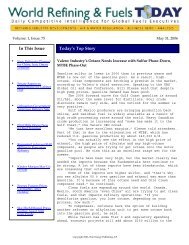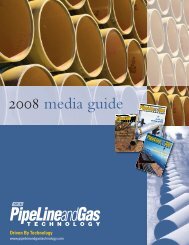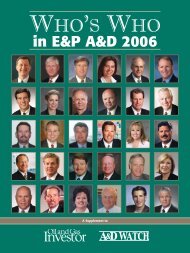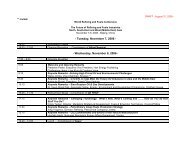ASTM: Gasoline Today and Tomorrow – An Executive Report
ASTM: Gasoline Today and Tomorrow – An Executive Report
ASTM: Gasoline Today and Tomorrow – An Executive Report
Create successful ePaper yourself
Turn your PDF publications into a flip-book with our unique Google optimized e-Paper software.
Octane Week | <strong>ASTM</strong>: <strong>Gasoline</strong> <strong>Today</strong> <strong>and</strong> <strong>Tomorrow</strong> - <strong>An</strong> <strong>Executive</strong> <strong>Report</strong><br />
(from p10) continued. Detergents impact the rate at<br />
which sulfates agglomerate on or pass through filters,<br />
“neither one a good option,” he added.<br />
ConocoPhillips worked with ethanol suppliers in a<br />
cooperative fashion <strong>and</strong> established a joint industry task<br />
force with other oil companies, automobile manufacturers<br />
<strong>and</strong> ethanol makers, Oliver told attendees at <strong>ASTM</strong>ʼs D-<br />
02 Committee meeting here. Since then, there has been<br />
little resolution of the issue, in part because there is no<br />
established test method. The IC method is thought to be<br />
impractical on an industry-wide basis.<br />
Decision on Ethanol Sulfate Detection<br />
With the cooperation of Flint Hills Resources, the<br />
two oil companies determined that a modified D-6174 test<br />
method could determine ethanol sulfate concentrations<br />
as low as 0.05 ppm. The modified test method results<br />
could also be correlated with the IC test results.<br />
“We need a sulfate spec in 4806,” Oliver said,<br />
referring to the st<strong>and</strong>ard specification for denatured<br />
ethanol. The industry investigation established a<br />
modified D 6174, the St<strong>and</strong>ard Test Method for Inorganic<br />
Sulfate in Surfactants by Potentiometric Lead Titration,<br />
as an alternative to IC, he said. “We are asking that the<br />
industry support the method weʼve put forward.”<br />
Four presentations later, the morning meeting<br />
adjourned. At the afternoon roundtable that followed,<br />
Dave Harvey of Citgo made a motion to ballot whether<br />
to add a 1-ppm sulfate limit in <strong>ASTM</strong>ʼs D-4806 ethanol<br />
specification, <strong>and</strong> to allow either test method, the IC<br />
D-6827, or the modified D-6174, the titration method,<br />
until a test method is finalized.<br />
Although supportive of the <strong>ASTM</strong> process,<br />
Bob Reynolds, representing the Renewable Fuels<br />
Association (RFA), objected to “fast tracking” the<br />
ballot. The modified titration test was only identified<br />
two weeks earlier <strong>and</strong> the correlation to the IC test only<br />
revealed hours earlier, he pointed out. “Weʼd be putting<br />
in spec controlled by a test method thatʼs not approved,”<br />
he told subcommittee members.<br />
“I would like to see it on a fast track,” countered<br />
Citgoʼs Harvey. While there are reasons to take the<br />
“more prudent” route <strong>and</strong> resolve the problem through<br />
<strong>ASTM</strong>ʼs normal, deliberative process, Harvey argued,<br />
“The fact is, we have a problem now.”<br />
In 2004, drivers in Milwaukee, Wis., started<br />
reporting vehicle operating problems. Fuel from<br />
Citgo, a major marketer in the region, was implicated<br />
as a possible cause. After investigation, Citgo also<br />
discovered troublesome levels of sulfates in ethanol.<br />
Owners face “thous<strong>and</strong>s of dollars of repairs” to<br />
out-of-warranty vehicles that might become affected,<br />
Harvey <strong>and</strong> others told roundtable participants.<br />
For <strong>and</strong> Against<br />
Members debated the issue extensively, raising<br />
numerous concerns. “Weʼve been shown clearly that<br />
high levels of sulfates, around 5 ppm, lead to a rise<br />
in field problems,” said Ronald Tharby of Tharby &<br />
Associates. “Seasonal use of ethanol has been tied in<br />
with a significant increase in field complaints, which<br />
are serious to drivers. What if there is a big breakout of<br />
this problem this winter?”<br />
Concerned that a 1-ppm sulfate spec might exclude<br />
a majority of ethanol from the gasoline pool, BPʼs Jim<br />
McGetrick sounded another alarm. As much as 75%<br />
of U.S. ethanol production is thought to exceed the<br />
proposed 1-ppm maximum sulfate st<strong>and</strong>ard. “Weʼve got<br />
m<strong>and</strong>ates for ethanol,” he said, referring to California,<br />
New York <strong>and</strong> Connecticut, where MTBE is banned.<br />
“If we take 75% of supply away, weʼve got problems.”<br />
“Thatʼs right, if everyone sits back <strong>and</strong> does<br />
nothing,” Harvey responded. With a rapidly exp<strong>and</strong>ing<br />
ethanol industry <strong>and</strong> more “mom <strong>and</strong> pop” producers,<br />
“this problem only gets worse,” Harvey warned.<br />
Sulfates must be addressed, he said, “so that we can<br />
exp<strong>and</strong> the use of ethanol.”<br />
One observer suggested that the ethanol industry<br />
is just going through typical growing problems.<br />
“Technology exists to remove sulfates from methanol,<br />
<strong>and</strong> the ethanol industry is just electing not to use them.<br />
They may be reluctant to do that, but we all have to<br />
improve our processes,” the commenter said.<br />
Ethanol producersʼ actual sulfate levels are far from<br />
certain, RFAʼs Reynolds said. Survey results are based on<br />
self-reporting using a variety of test methods. “We need to<br />
find out what our numbers are,” he admitted. “We support<br />
work on a test method,” he said, <strong>and</strong> RFA would favor<br />
making the modified titration test part of a round robin.<br />
After the debate, subcommittee members voted 23-<br />
13 in favor of Harveyʼs motion to ballot the issue. By the<br />
time of D-02Aʼs December meeting, it should be known<br />
whether the subcommittee members favor the addition<br />
of a sulfate limit to <strong>ASTM</strong>ʼs ethanol specification.<br />
— Carol Cole<br />
February 2007 11
















